Assessment Task 2: Research Paper on Procurement Process Analysis
VerifiedAdded on 2020/10/10
|13
|3855
|94
Report
AI Summary
This research paper investigates procurement processes by analyzing three academic research articles on supply chain inventory and three case studies or good practice examples of procurement snapshots. The paper identifies problems within inventory and stock management of organizations, exploring how issues of inventory management can be overcome using various methods. The research articles cover topics such as process flexibility, Kanban and JIT systems, and work-in-process inventory. The case studies discuss lean thinking in clinical trials, RFID and lean thinking in a university hospital, and Suncor Energy's partnerships with drilling suppliers. The paper discusses how the findings of these research articles can assist in addressing procurement management related issues for the case studies and organizations chosen in assignment 1, ultimately aiming to minimize lean time and improve operational efficiency within companies.
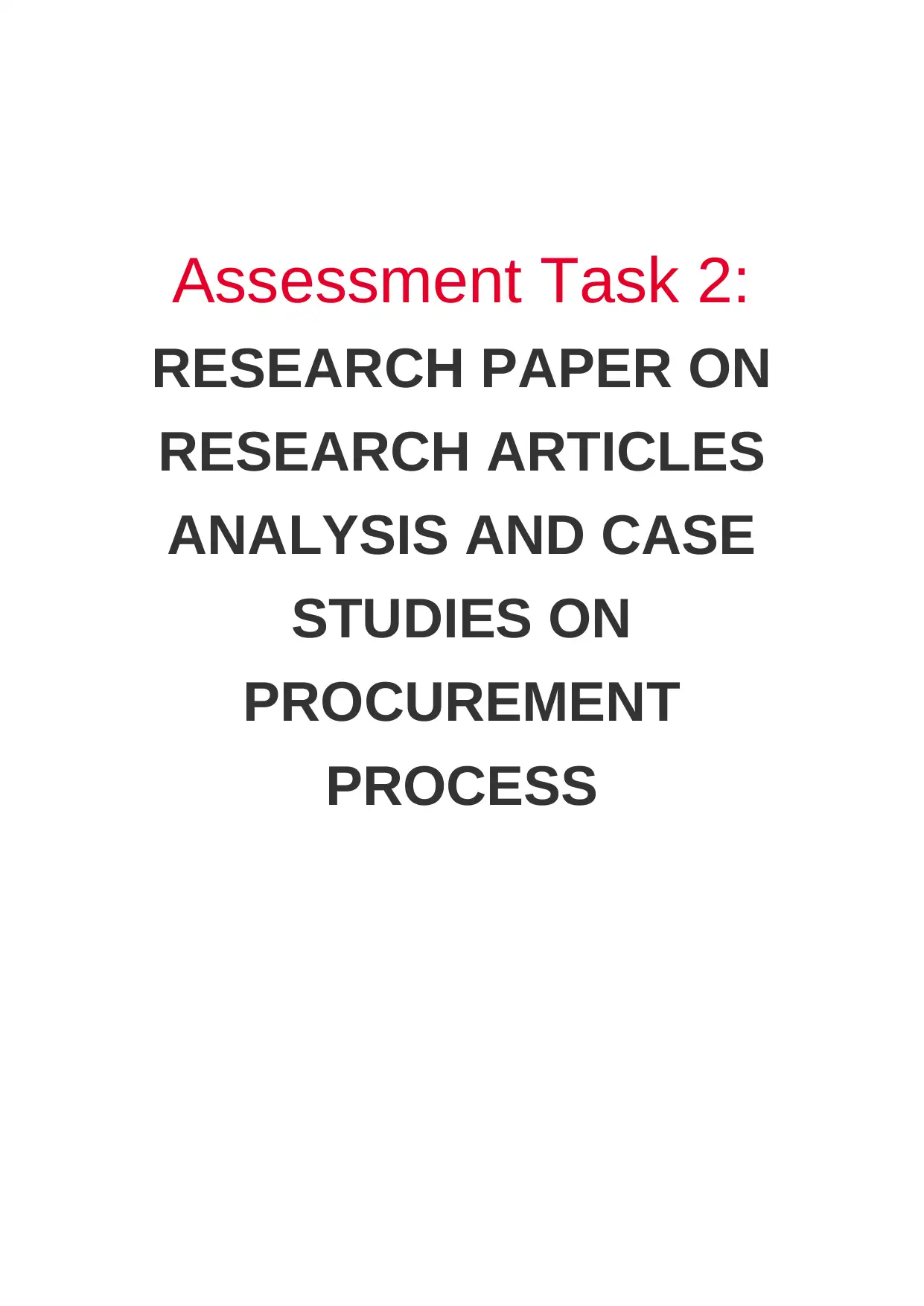
Assessment Task 2:
RESEARCH PAPER ON
RESEARCH ARTICLES
ANALYSIS AND CASE
STUDIES ON
PROCUREMENT
PROCESS
RESEARCH PAPER ON
RESEARCH ARTICLES
ANALYSIS AND CASE
STUDIES ON
PROCUREMENT
PROCESS
Paraphrase This Document
Need a fresh take? Get an instant paraphrase of this document with our AI Paraphraser
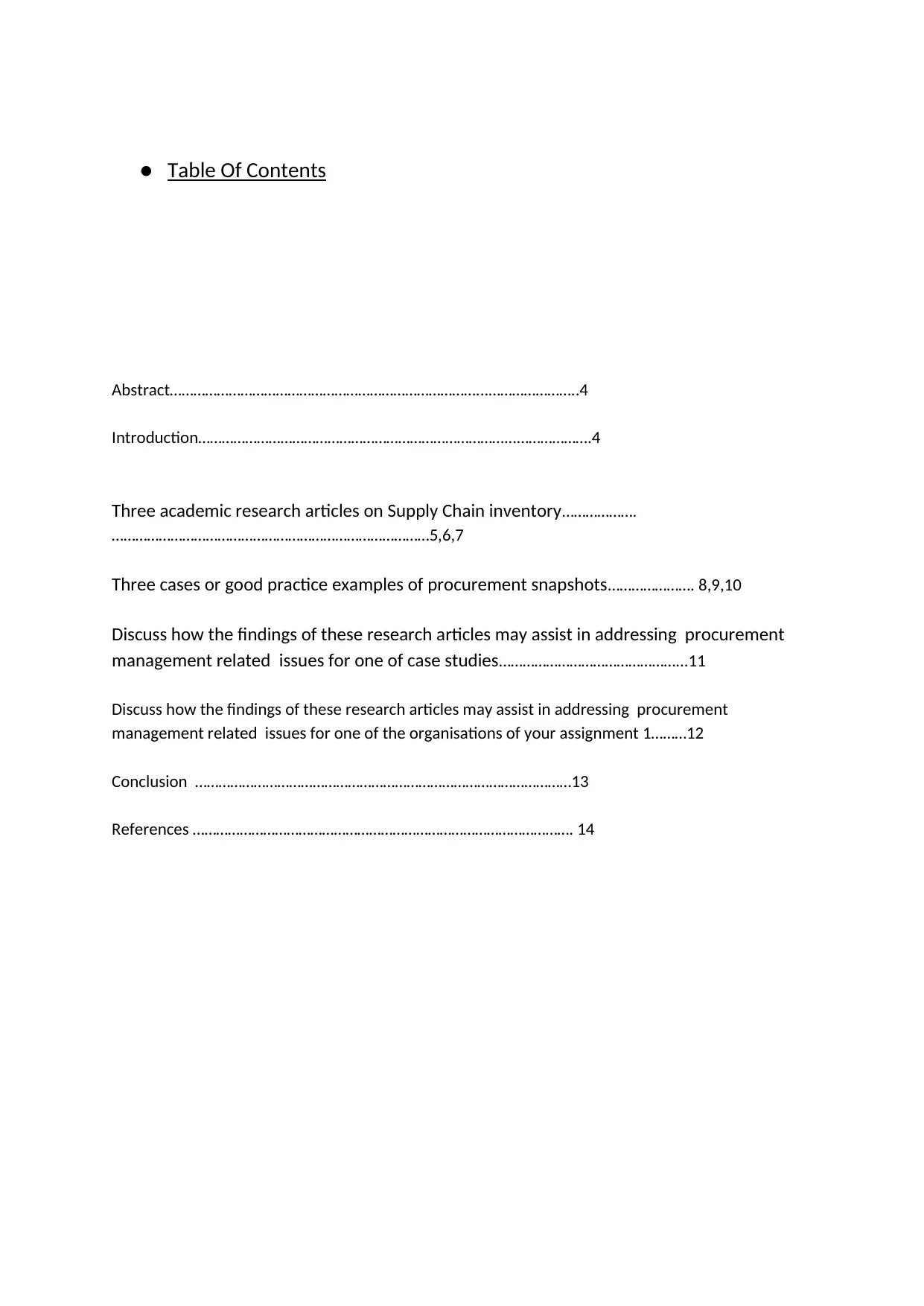
● Table Of Contents
Abstract……………………………………………………………………...…………………..4
Introduction……………………………………………………………………...……………….4
Three academic research articles on Supply Chain inventory……………….
………………………………………………………………………5,6,7
Three cases or good practice examples of procurement snapshots…………………. 8,9,10
Discuss how the findings of these research articles may assist in addressing procurement
management related issues for one of case studies………………………………………...11
Discuss how the findings of these research articles may assist in addressing procurement
management related issues for one of the organisations of your assignment 1………12
Conclusion ……………………………………………………………………………………13
References ……………………………………………………………………………………. 14
Abstract……………………………………………………………………...…………………..4
Introduction……………………………………………………………………...……………….4
Three academic research articles on Supply Chain inventory……………….
………………………………………………………………………5,6,7
Three cases or good practice examples of procurement snapshots…………………. 8,9,10
Discuss how the findings of these research articles may assist in addressing procurement
management related issues for one of case studies………………………………………...11
Discuss how the findings of these research articles may assist in addressing procurement
management related issues for one of the organisations of your assignment 1………12
Conclusion ……………………………………………………………………………………13
References ……………………………………………………………………………………. 14
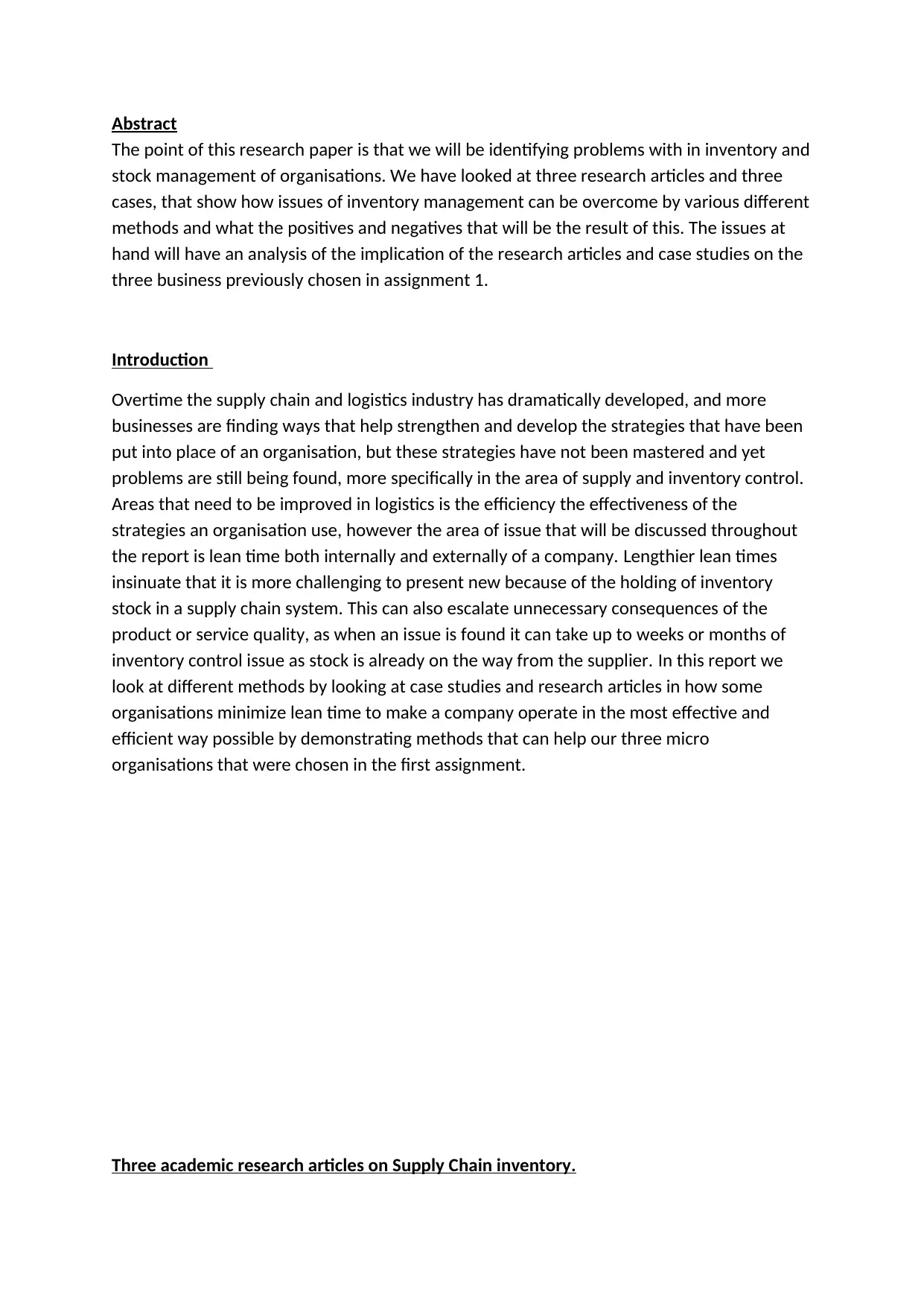
Abstract
The point of this research paper is that we will be identifying problems with in inventory and
stock management of organisations. We have looked at three research articles and three
cases, that show how issues of inventory management can be overcome by various different
methods and what the positives and negatives that will be the result of this. The issues at
hand will have an analysis of the implication of the research articles and case studies on the
three business previously chosen in assignment 1.
Introduction
Overtime the supply chain and logistics industry has dramatically developed, and more
businesses are finding ways that help strengthen and develop the strategies that have been
put into place of an organisation, but these strategies have not been mastered and yet
problems are still being found, more specifically in the area of supply and inventory control.
Areas that need to be improved in logistics is the efficiency the effectiveness of the
strategies an organisation use, however the area of issue that will be discussed throughout
the report is lean time both internally and externally of a company. Lengthier lean times
insinuate that it is more challenging to present new because of the holding of inventory
stock in a supply chain system. This can also escalate unnecessary consequences of the
product or service quality, as when an issue is found it can take up to weeks or months of
inventory control issue as stock is already on the way from the supplier. In this report we
look at different methods by looking at case studies and research articles in how some
organisations minimize lean time to make a company operate in the most effective and
efficient way possible by demonstrating methods that can help our three micro
organisations that were chosen in the first assignment.
Three academic research articles on Supply Chain inventory.
The point of this research paper is that we will be identifying problems with in inventory and
stock management of organisations. We have looked at three research articles and three
cases, that show how issues of inventory management can be overcome by various different
methods and what the positives and negatives that will be the result of this. The issues at
hand will have an analysis of the implication of the research articles and case studies on the
three business previously chosen in assignment 1.
Introduction
Overtime the supply chain and logistics industry has dramatically developed, and more
businesses are finding ways that help strengthen and develop the strategies that have been
put into place of an organisation, but these strategies have not been mastered and yet
problems are still being found, more specifically in the area of supply and inventory control.
Areas that need to be improved in logistics is the efficiency the effectiveness of the
strategies an organisation use, however the area of issue that will be discussed throughout
the report is lean time both internally and externally of a company. Lengthier lean times
insinuate that it is more challenging to present new because of the holding of inventory
stock in a supply chain system. This can also escalate unnecessary consequences of the
product or service quality, as when an issue is found it can take up to weeks or months of
inventory control issue as stock is already on the way from the supplier. In this report we
look at different methods by looking at case studies and research articles in how some
organisations minimize lean time to make a company operate in the most effective and
efficient way possible by demonstrating methods that can help our three micro
organisations that were chosen in the first assignment.
Three academic research articles on Supply Chain inventory.
⊘ This is a preview!⊘
Do you want full access?
Subscribe today to unlock all pages.

Trusted by 1+ million students worldwide
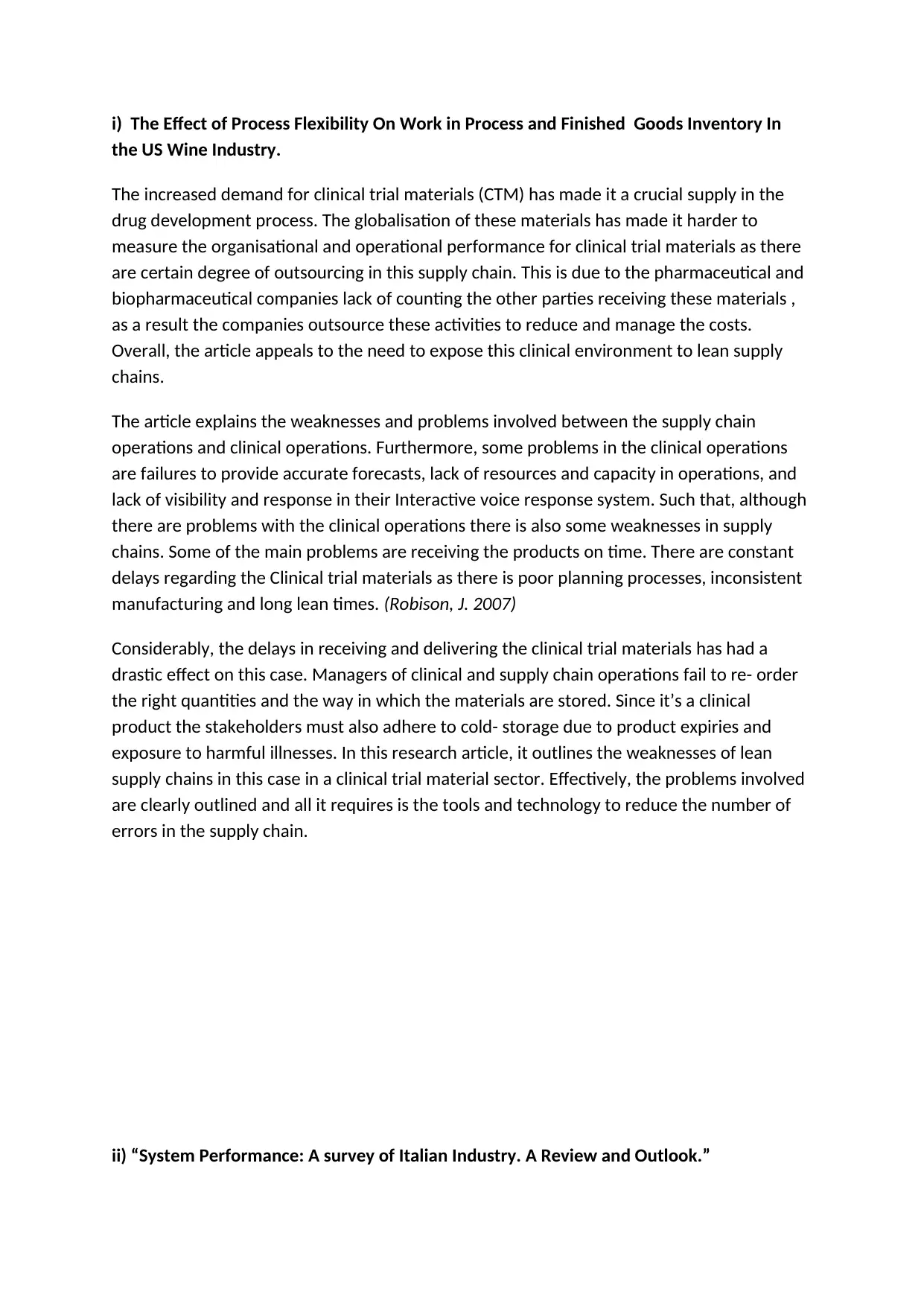
i) The Effect of Process Flexibility On Work in Process and Finished Goods Inventory In
the US Wine Industry.
The increased demand for clinical trial materials (CTM) has made it a crucial supply in the
drug development process. The globalisation of these materials has made it harder to
measure the organisational and operational performance for clinical trial materials as there
are certain degree of outsourcing in this supply chain. This is due to the pharmaceutical and
biopharmaceutical companies lack of counting the other parties receiving these materials ,
as a result the companies outsource these activities to reduce and manage the costs.
Overall, the article appeals to the need to expose this clinical environment to lean supply
chains.
The article explains the weaknesses and problems involved between the supply chain
operations and clinical operations. Furthermore, some problems in the clinical operations
are failures to provide accurate forecasts, lack of resources and capacity in operations, and
lack of visibility and response in their Interactive voice response system. Such that, although
there are problems with the clinical operations there is also some weaknesses in supply
chains. Some of the main problems are receiving the products on time. There are constant
delays regarding the Clinical trial materials as there is poor planning processes, inconsistent
manufacturing and long lean times. (Robison, J. 2007)
Considerably, the delays in receiving and delivering the clinical trial materials has had a
drastic effect on this case. Managers of clinical and supply chain operations fail to re- order
the right quantities and the way in which the materials are stored. Since it’s a clinical
product the stakeholders must also adhere to cold- storage due to product expiries and
exposure to harmful illnesses. In this research article, it outlines the weaknesses of lean
supply chains in this case in a clinical trial material sector. Effectively, the problems involved
are clearly outlined and all it requires is the tools and technology to reduce the number of
errors in the supply chain.
ii) “System Performance: A survey of Italian Industry. A Review and Outlook.”
the US Wine Industry.
The increased demand for clinical trial materials (CTM) has made it a crucial supply in the
drug development process. The globalisation of these materials has made it harder to
measure the organisational and operational performance for clinical trial materials as there
are certain degree of outsourcing in this supply chain. This is due to the pharmaceutical and
biopharmaceutical companies lack of counting the other parties receiving these materials ,
as a result the companies outsource these activities to reduce and manage the costs.
Overall, the article appeals to the need to expose this clinical environment to lean supply
chains.
The article explains the weaknesses and problems involved between the supply chain
operations and clinical operations. Furthermore, some problems in the clinical operations
are failures to provide accurate forecasts, lack of resources and capacity in operations, and
lack of visibility and response in their Interactive voice response system. Such that, although
there are problems with the clinical operations there is also some weaknesses in supply
chains. Some of the main problems are receiving the products on time. There are constant
delays regarding the Clinical trial materials as there is poor planning processes, inconsistent
manufacturing and long lean times. (Robison, J. 2007)
Considerably, the delays in receiving and delivering the clinical trial materials has had a
drastic effect on this case. Managers of clinical and supply chain operations fail to re- order
the right quantities and the way in which the materials are stored. Since it’s a clinical
product the stakeholders must also adhere to cold- storage due to product expiries and
exposure to harmful illnesses. In this research article, it outlines the weaknesses of lean
supply chains in this case in a clinical trial material sector. Effectively, the problems involved
are clearly outlined and all it requires is the tools and technology to reduce the number of
errors in the supply chain.
ii) “System Performance: A survey of Italian Industry. A Review and Outlook.”
Paraphrase This Document
Need a fresh take? Get an instant paraphrase of this document with our AI Paraphraser
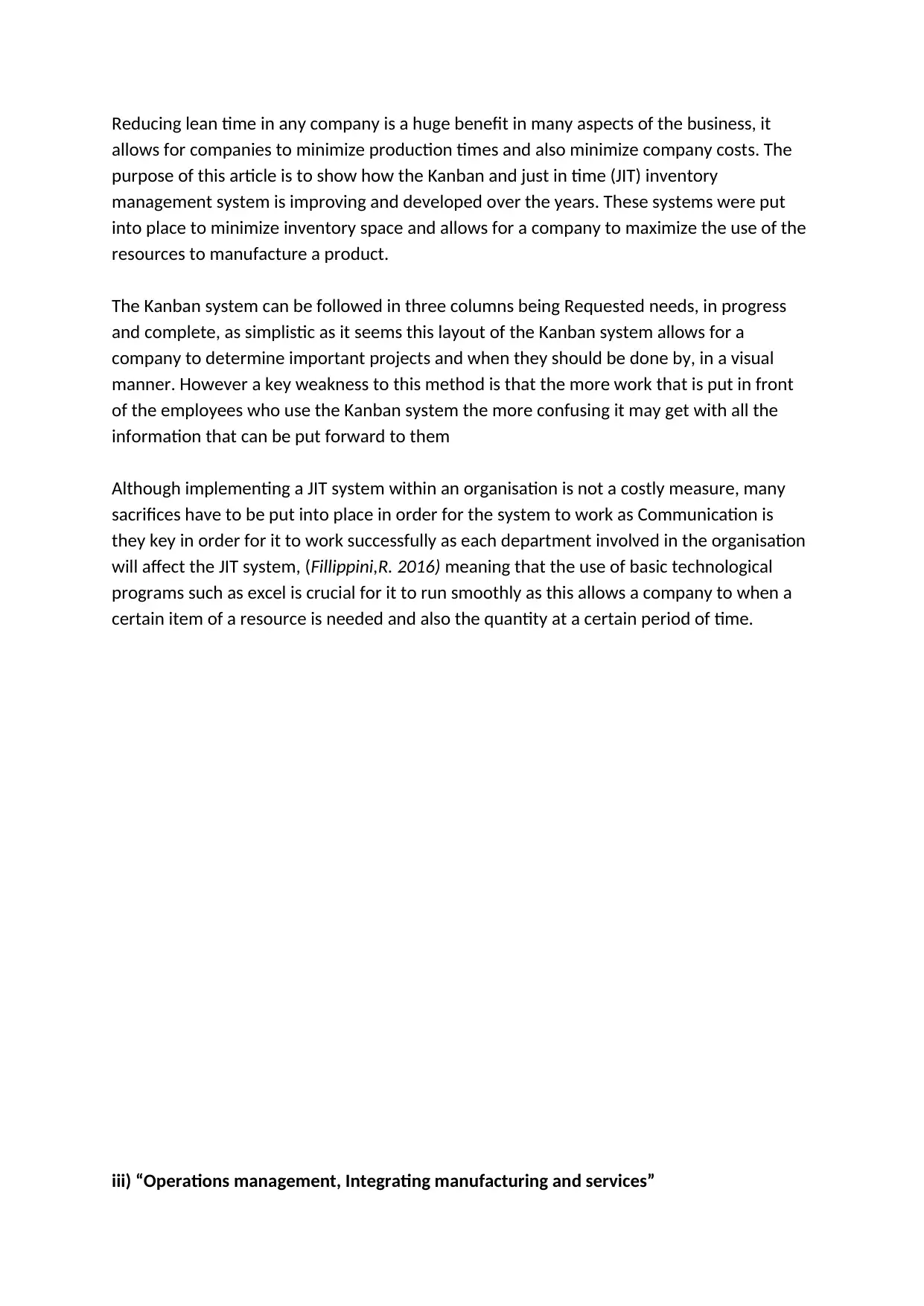
Reducing lean time in any company is a huge benefit in many aspects of the business, it
allows for companies to minimize production times and also minimize company costs. The
purpose of this article is to show how the Kanban and just in time (JIT) inventory
management system is improving and developed over the years. These systems were put
into place to minimize inventory space and allows for a company to maximize the use of the
resources to manufacture a product.
The Kanban system can be followed in three columns being Requested needs, in progress
and complete, as simplistic as it seems this layout of the Kanban system allows for a
company to determine important projects and when they should be done by, in a visual
manner. However a key weakness to this method is that the more work that is put in front
of the employees who use the Kanban system the more confusing it may get with all the
information that can be put forward to them
Although implementing a JIT system within an organisation is not a costly measure, many
sacrifices have to be put into place in order for the system to work as Communication is
they key in order for it to work successfully as each department involved in the organisation
will affect the JIT system, (Fillippini,R. 2016) meaning that the use of basic technological
programs such as excel is crucial for it to run smoothly as this allows a company to when a
certain item of a resource is needed and also the quantity at a certain period of time.
iii) “Operations management, Integrating manufacturing and services”
allows for companies to minimize production times and also minimize company costs. The
purpose of this article is to show how the Kanban and just in time (JIT) inventory
management system is improving and developed over the years. These systems were put
into place to minimize inventory space and allows for a company to maximize the use of the
resources to manufacture a product.
The Kanban system can be followed in three columns being Requested needs, in progress
and complete, as simplistic as it seems this layout of the Kanban system allows for a
company to determine important projects and when they should be done by, in a visual
manner. However a key weakness to this method is that the more work that is put in front
of the employees who use the Kanban system the more confusing it may get with all the
information that can be put forward to them
Although implementing a JIT system within an organisation is not a costly measure, many
sacrifices have to be put into place in order for the system to work as Communication is
they key in order for it to work successfully as each department involved in the organisation
will affect the JIT system, (Fillippini,R. 2016) meaning that the use of basic technological
programs such as excel is crucial for it to run smoothly as this allows a company to when a
certain item of a resource is needed and also the quantity at a certain period of time.
iii) “Operations management, Integrating manufacturing and services”
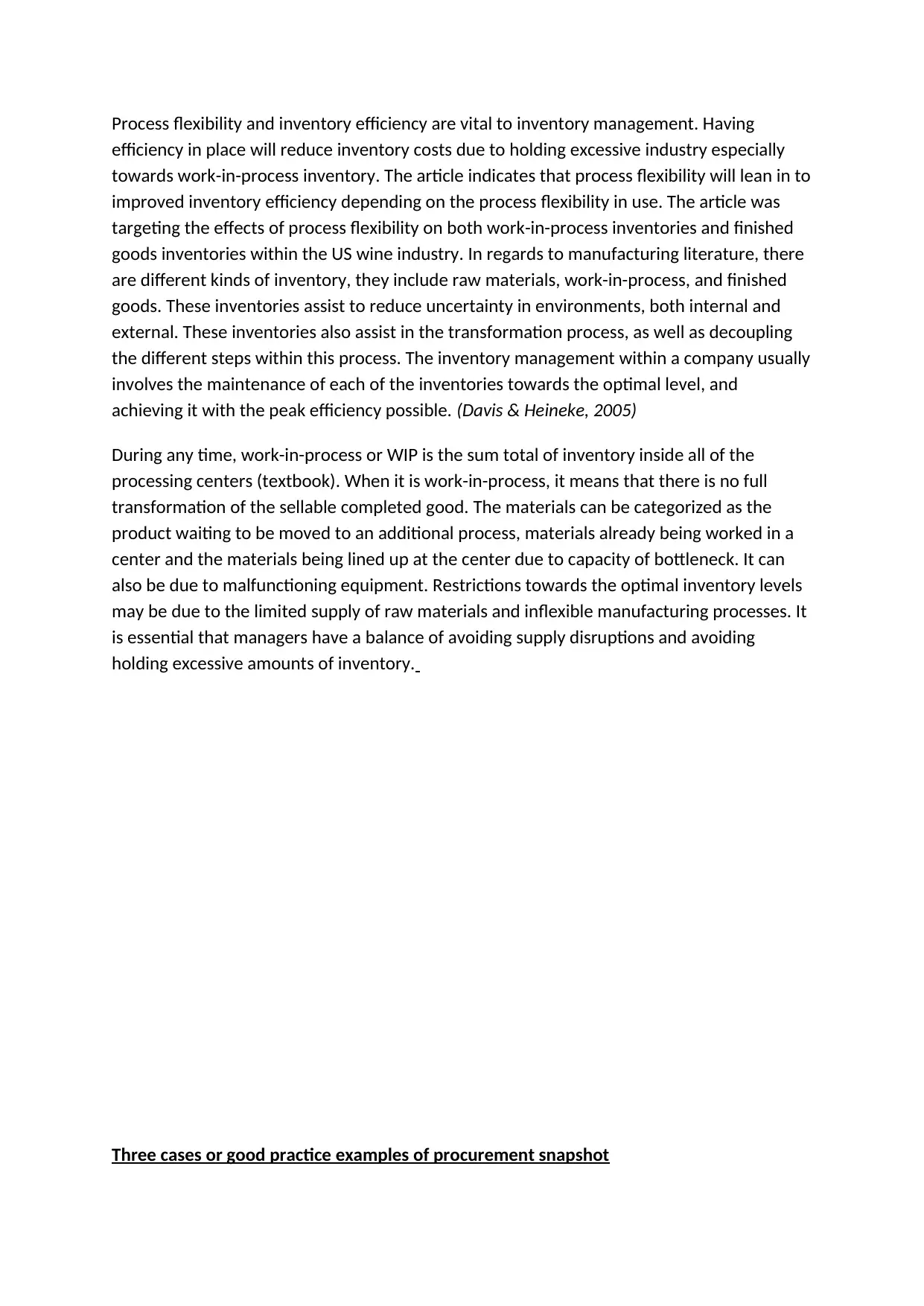
Process flexibility and inventory efficiency are vital to inventory management. Having
efficiency in place will reduce inventory costs due to holding excessive industry especially
towards work-in-process inventory. The article indicates that process flexibility will lean in to
improved inventory efficiency depending on the process flexibility in use. The article was
targeting the effects of process flexibility on both work-in-process inventories and finished
goods inventories within the US wine industry. In regards to manufacturing literature, there
are different kinds of inventory, they include raw materials, work-in-process, and finished
goods. These inventories assist to reduce uncertainty in environments, both internal and
external. These inventories also assist in the transformation process, as well as decoupling
the different steps within this process. The inventory management within a company usually
involves the maintenance of each of the inventories towards the optimal level, and
achieving it with the peak efficiency possible. (Davis & Heineke, 2005)
During any time, work-in-process or WIP is the sum total of inventory inside all of the
processing centers (textbook). When it is work-in-process, it means that there is no full
transformation of the sellable completed good. The materials can be categorized as the
product waiting to be moved to an additional process, materials already being worked in a
center and the materials being lined up at the center due to capacity of bottleneck. It can
also be due to malfunctioning equipment. Restrictions towards the optimal inventory levels
may be due to the limited supply of raw materials and inflexible manufacturing processes. It
is essential that managers have a balance of avoiding supply disruptions and avoiding
holding excessive amounts of inventory.
Three cases or good practice examples of procurement snapshot
efficiency in place will reduce inventory costs due to holding excessive industry especially
towards work-in-process inventory. The article indicates that process flexibility will lean in to
improved inventory efficiency depending on the process flexibility in use. The article was
targeting the effects of process flexibility on both work-in-process inventories and finished
goods inventories within the US wine industry. In regards to manufacturing literature, there
are different kinds of inventory, they include raw materials, work-in-process, and finished
goods. These inventories assist to reduce uncertainty in environments, both internal and
external. These inventories also assist in the transformation process, as well as decoupling
the different steps within this process. The inventory management within a company usually
involves the maintenance of each of the inventories towards the optimal level, and
achieving it with the peak efficiency possible. (Davis & Heineke, 2005)
During any time, work-in-process or WIP is the sum total of inventory inside all of the
processing centers (textbook). When it is work-in-process, it means that there is no full
transformation of the sellable completed good. The materials can be categorized as the
product waiting to be moved to an additional process, materials already being worked in a
center and the materials being lined up at the center due to capacity of bottleneck. It can
also be due to malfunctioning equipment. Restrictions towards the optimal inventory levels
may be due to the limited supply of raw materials and inflexible manufacturing processes. It
is essential that managers have a balance of avoiding supply disruptions and avoiding
holding excessive amounts of inventory.
Three cases or good practice examples of procurement snapshot
⊘ This is a preview!⊘
Do you want full access?
Subscribe today to unlock all pages.

Trusted by 1+ million students worldwide
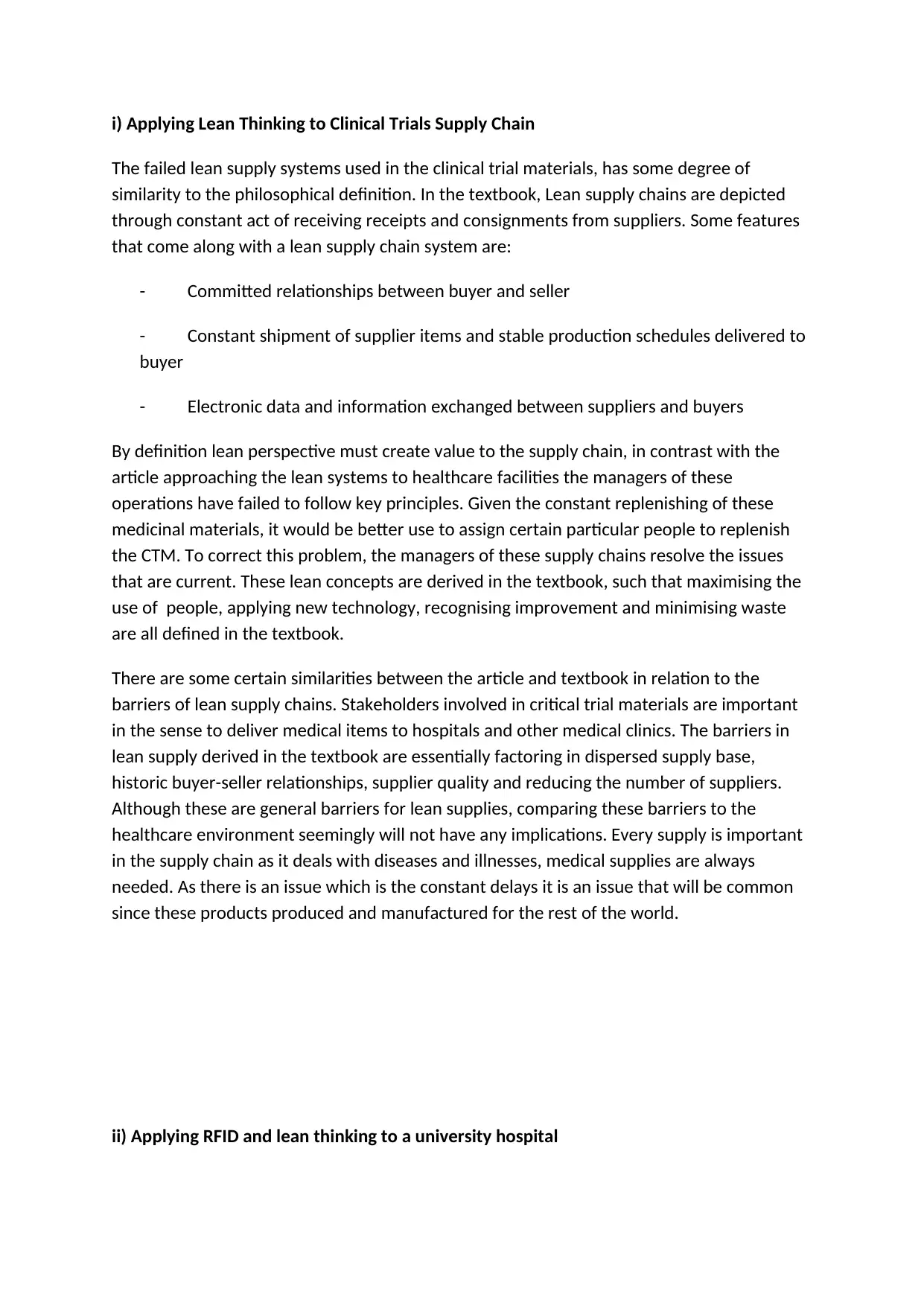
i) Applying Lean Thinking to Clinical Trials Supply Chain
The failed lean supply systems used in the clinical trial materials, has some degree of
similarity to the philosophical definition. In the textbook, Lean supply chains are depicted
through constant act of receiving receipts and consignments from suppliers. Some features
that come along with a lean supply chain system are:
- Committed relationships between buyer and seller
- Constant shipment of supplier items and stable production schedules delivered to
buyer
- Electronic data and information exchanged between suppliers and buyers
By definition lean perspective must create value to the supply chain, in contrast with the
article approaching the lean systems to healthcare facilities the managers of these
operations have failed to follow key principles. Given the constant replenishing of these
medicinal materials, it would be better use to assign certain particular people to replenish
the CTM. To correct this problem, the managers of these supply chains resolve the issues
that are current. These lean concepts are derived in the textbook, such that maximising the
use of people, applying new technology, recognising improvement and minimising waste
are all defined in the textbook.
There are some certain similarities between the article and textbook in relation to the
barriers of lean supply chains. Stakeholders involved in critical trial materials are important
in the sense to deliver medical items to hospitals and other medical clinics. The barriers in
lean supply derived in the textbook are essentially factoring in dispersed supply base,
historic buyer-seller relationships, supplier quality and reducing the number of suppliers.
Although these are general barriers for lean supplies, comparing these barriers to the
healthcare environment seemingly will not have any implications. Every supply is important
in the supply chain as it deals with diseases and illnesses, medical supplies are always
needed. As there is an issue which is the constant delays it is an issue that will be common
since these products produced and manufactured for the rest of the world.
ii) Applying RFID and lean thinking to a university hospital
The failed lean supply systems used in the clinical trial materials, has some degree of
similarity to the philosophical definition. In the textbook, Lean supply chains are depicted
through constant act of receiving receipts and consignments from suppliers. Some features
that come along with a lean supply chain system are:
- Committed relationships between buyer and seller
- Constant shipment of supplier items and stable production schedules delivered to
buyer
- Electronic data and information exchanged between suppliers and buyers
By definition lean perspective must create value to the supply chain, in contrast with the
article approaching the lean systems to healthcare facilities the managers of these
operations have failed to follow key principles. Given the constant replenishing of these
medicinal materials, it would be better use to assign certain particular people to replenish
the CTM. To correct this problem, the managers of these supply chains resolve the issues
that are current. These lean concepts are derived in the textbook, such that maximising the
use of people, applying new technology, recognising improvement and minimising waste
are all defined in the textbook.
There are some certain similarities between the article and textbook in relation to the
barriers of lean supply chains. Stakeholders involved in critical trial materials are important
in the sense to deliver medical items to hospitals and other medical clinics. The barriers in
lean supply derived in the textbook are essentially factoring in dispersed supply base,
historic buyer-seller relationships, supplier quality and reducing the number of suppliers.
Although these are general barriers for lean supplies, comparing these barriers to the
healthcare environment seemingly will not have any implications. Every supply is important
in the supply chain as it deals with diseases and illnesses, medical supplies are always
needed. As there is an issue which is the constant delays it is an issue that will be common
since these products produced and manufactured for the rest of the world.
ii) Applying RFID and lean thinking to a university hospital
Paraphrase This Document
Need a fresh take? Get an instant paraphrase of this document with our AI Paraphraser
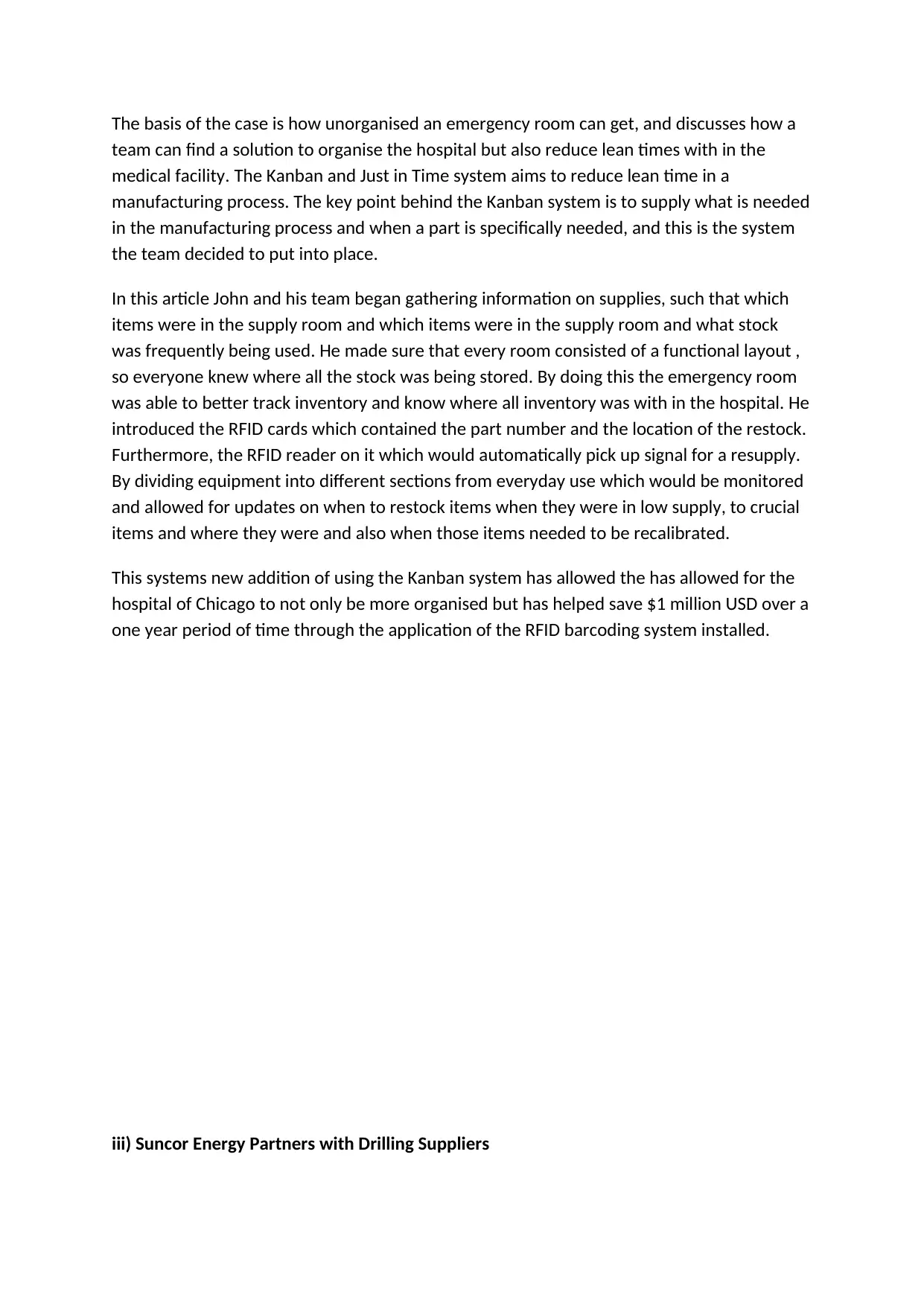
The basis of the case is how unorganised an emergency room can get, and discusses how a
team can find a solution to organise the hospital but also reduce lean times with in the
medical facility. The Kanban and Just in Time system aims to reduce lean time in a
manufacturing process. The key point behind the Kanban system is to supply what is needed
in the manufacturing process and when a part is specifically needed, and this is the system
the team decided to put into place.
In this article John and his team began gathering information on supplies, such that which
items were in the supply room and which items were in the supply room and what stock
was frequently being used. He made sure that every room consisted of a functional layout ,
so everyone knew where all the stock was being stored. By doing this the emergency room
was able to better track inventory and know where all inventory was with in the hospital. He
introduced the RFID cards which contained the part number and the location of the restock.
Furthermore, the RFID reader on it which would automatically pick up signal for a resupply.
By dividing equipment into different sections from everyday use which would be monitored
and allowed for updates on when to restock items when they were in low supply, to crucial
items and where they were and also when those items needed to be recalibrated.
This systems new addition of using the Kanban system has allowed the has allowed for the
hospital of Chicago to not only be more organised but has helped save $1 million USD over a
one year period of time through the application of the RFID barcoding system installed.
iii) Suncor Energy Partners with Drilling Suppliers
team can find a solution to organise the hospital but also reduce lean times with in the
medical facility. The Kanban and Just in Time system aims to reduce lean time in a
manufacturing process. The key point behind the Kanban system is to supply what is needed
in the manufacturing process and when a part is specifically needed, and this is the system
the team decided to put into place.
In this article John and his team began gathering information on supplies, such that which
items were in the supply room and which items were in the supply room and what stock
was frequently being used. He made sure that every room consisted of a functional layout ,
so everyone knew where all the stock was being stored. By doing this the emergency room
was able to better track inventory and know where all inventory was with in the hospital. He
introduced the RFID cards which contained the part number and the location of the restock.
Furthermore, the RFID reader on it which would automatically pick up signal for a resupply.
By dividing equipment into different sections from everyday use which would be monitored
and allowed for updates on when to restock items when they were in low supply, to crucial
items and where they were and also when those items needed to be recalibrated.
This systems new addition of using the Kanban system has allowed the has allowed for the
hospital of Chicago to not only be more organised but has helped save $1 million USD over a
one year period of time through the application of the RFID barcoding system installed.
iii) Suncor Energy Partners with Drilling Suppliers
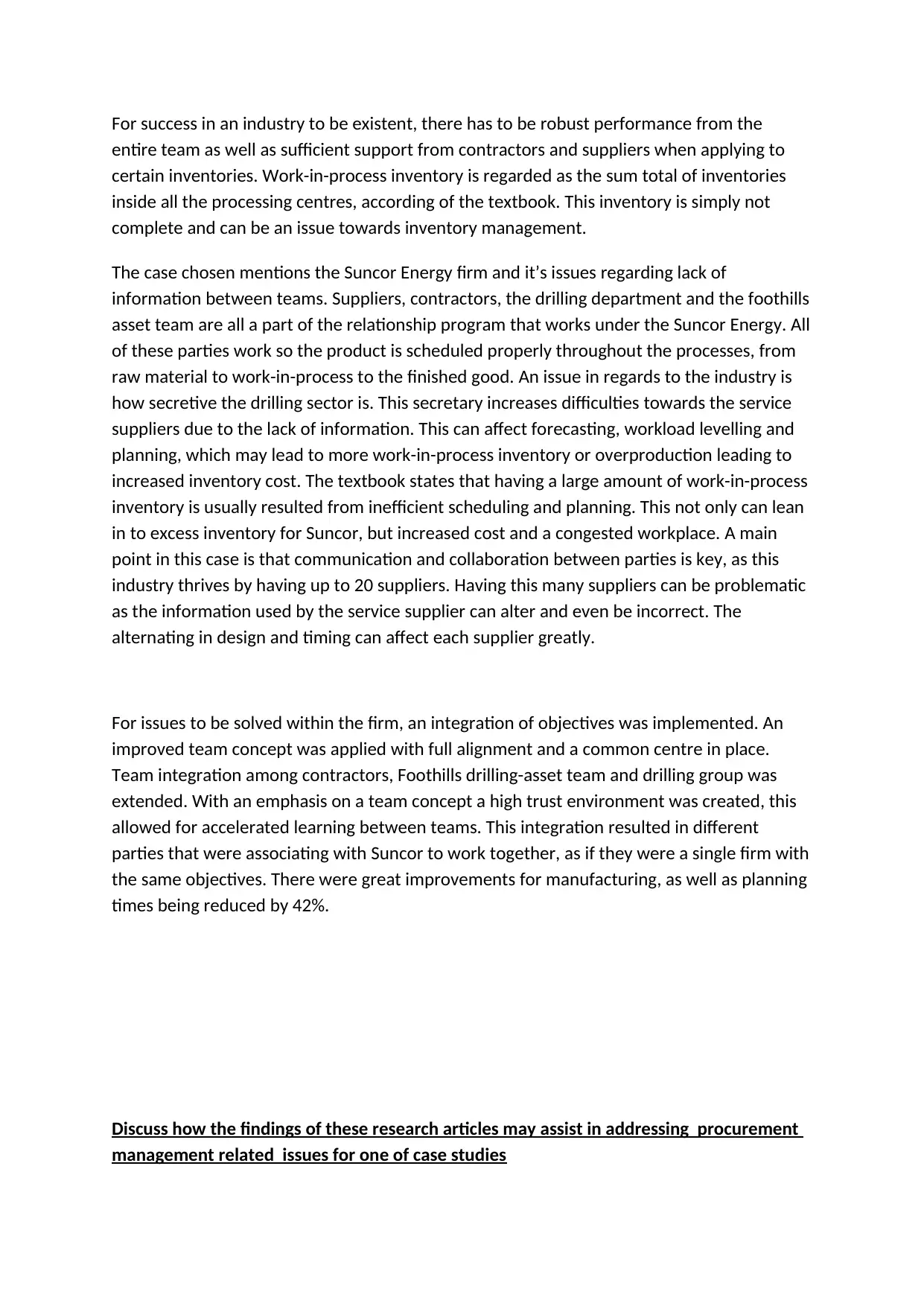
For success in an industry to be existent, there has to be robust performance from the
entire team as well as sufficient support from contractors and suppliers when applying to
certain inventories. Work-in-process inventory is regarded as the sum total of inventories
inside all the processing centres, according of the textbook. This inventory is simply not
complete and can be an issue towards inventory management.
The case chosen mentions the Suncor Energy firm and it’s issues regarding lack of
information between teams. Suppliers, contractors, the drilling department and the foothills
asset team are all a part of the relationship program that works under the Suncor Energy. All
of these parties work so the product is scheduled properly throughout the processes, from
raw material to work-in-process to the finished good. An issue in regards to the industry is
how secretive the drilling sector is. This secretary increases difficulties towards the service
suppliers due to the lack of information. This can affect forecasting, workload levelling and
planning, which may lead to more work-in-process inventory or overproduction leading to
increased inventory cost. The textbook states that having a large amount of work-in-process
inventory is usually resulted from inefficient scheduling and planning. This not only can lean
in to excess inventory for Suncor, but increased cost and a congested workplace. A main
point in this case is that communication and collaboration between parties is key, as this
industry thrives by having up to 20 suppliers. Having this many suppliers can be problematic
as the information used by the service supplier can alter and even be incorrect. The
alternating in design and timing can affect each supplier greatly.
For issues to be solved within the firm, an integration of objectives was implemented. An
improved team concept was applied with full alignment and a common centre in place.
Team integration among contractors, Foothills drilling-asset team and drilling group was
extended. With an emphasis on a team concept a high trust environment was created, this
allowed for accelerated learning between teams. This integration resulted in different
parties that were associating with Suncor to work together, as if they were a single firm with
the same objectives. There were great improvements for manufacturing, as well as planning
times being reduced by 42%.
Discuss how the findings of these research articles may assist in addressing procurement
management related issues for one of case studies
entire team as well as sufficient support from contractors and suppliers when applying to
certain inventories. Work-in-process inventory is regarded as the sum total of inventories
inside all the processing centres, according of the textbook. This inventory is simply not
complete and can be an issue towards inventory management.
The case chosen mentions the Suncor Energy firm and it’s issues regarding lack of
information between teams. Suppliers, contractors, the drilling department and the foothills
asset team are all a part of the relationship program that works under the Suncor Energy. All
of these parties work so the product is scheduled properly throughout the processes, from
raw material to work-in-process to the finished good. An issue in regards to the industry is
how secretive the drilling sector is. This secretary increases difficulties towards the service
suppliers due to the lack of information. This can affect forecasting, workload levelling and
planning, which may lead to more work-in-process inventory or overproduction leading to
increased inventory cost. The textbook states that having a large amount of work-in-process
inventory is usually resulted from inefficient scheduling and planning. This not only can lean
in to excess inventory for Suncor, but increased cost and a congested workplace. A main
point in this case is that communication and collaboration between parties is key, as this
industry thrives by having up to 20 suppliers. Having this many suppliers can be problematic
as the information used by the service supplier can alter and even be incorrect. The
alternating in design and timing can affect each supplier greatly.
For issues to be solved within the firm, an integration of objectives was implemented. An
improved team concept was applied with full alignment and a common centre in place.
Team integration among contractors, Foothills drilling-asset team and drilling group was
extended. With an emphasis on a team concept a high trust environment was created, this
allowed for accelerated learning between teams. This integration resulted in different
parties that were associating with Suncor to work together, as if they were a single firm with
the same objectives. There were great improvements for manufacturing, as well as planning
times being reduced by 42%.
Discuss how the findings of these research articles may assist in addressing procurement
management related issues for one of case studies
⊘ This is a preview!⊘
Do you want full access?
Subscribe today to unlock all pages.

Trusted by 1+ million students worldwide
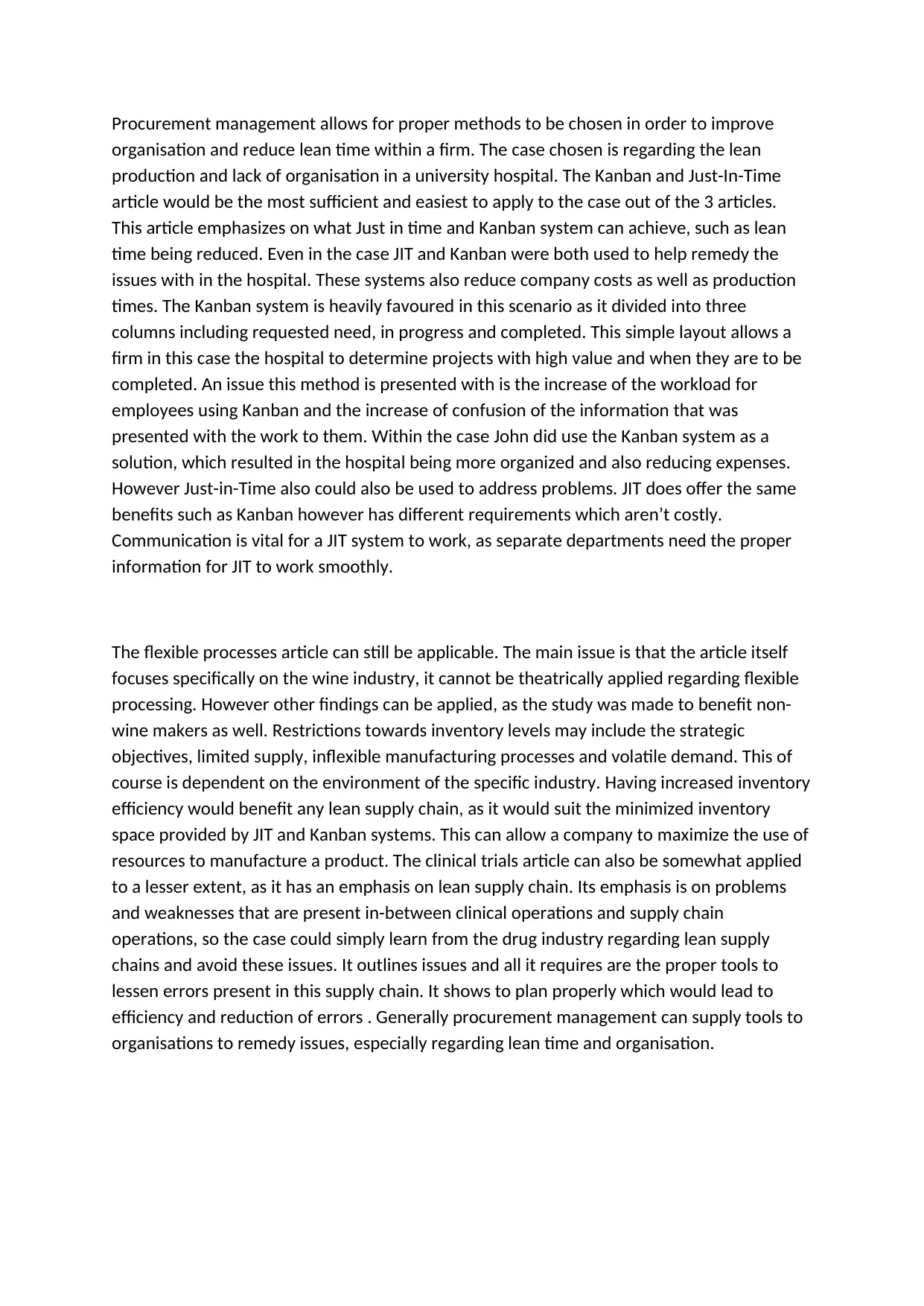
Procurement management allows for proper methods to be chosen in order to improve
organisation and reduce lean time within a firm. The case chosen is regarding the lean
production and lack of organisation in a university hospital. The Kanban and Just-In-Time
article would be the most sufficient and easiest to apply to the case out of the 3 articles.
This article emphasizes on what Just in time and Kanban system can achieve, such as lean
time being reduced. Even in the case JIT and Kanban were both used to help remedy the
issues with in the hospital. These systems also reduce company costs as well as production
times. The Kanban system is heavily favoured in this scenario as it divided into three
columns including requested need, in progress and completed. This simple layout allows a
firm in this case the hospital to determine projects with high value and when they are to be
completed. An issue this method is presented with is the increase of the workload for
employees using Kanban and the increase of confusion of the information that was
presented with the work to them. Within the case John did use the Kanban system as a
solution, which resulted in the hospital being more organized and also reducing expenses.
However Just-in-Time also could also be used to address problems. JIT does offer the same
benefits such as Kanban however has different requirements which aren’t costly.
Communication is vital for a JIT system to work, as separate departments need the proper
information for JIT to work smoothly.
The flexible processes article can still be applicable. The main issue is that the article itself
focuses specifically on the wine industry, it cannot be theatrically applied regarding flexible
processing. However other findings can be applied, as the study was made to benefit non-
wine makers as well. Restrictions towards inventory levels may include the strategic
objectives, limited supply, inflexible manufacturing processes and volatile demand. This of
course is dependent on the environment of the specific industry. Having increased inventory
efficiency would benefit any lean supply chain, as it would suit the minimized inventory
space provided by JIT and Kanban systems. This can allow a company to maximize the use of
resources to manufacture a product. The clinical trials article can also be somewhat applied
to a lesser extent, as it has an emphasis on lean supply chain. Its emphasis is on problems
and weaknesses that are present in-between clinical operations and supply chain
operations, so the case could simply learn from the drug industry regarding lean supply
chains and avoid these issues. It outlines issues and all it requires are the proper tools to
lessen errors present in this supply chain. It shows to plan properly which would lead to
efficiency and reduction of errors . Generally procurement management can supply tools to
organisations to remedy issues, especially regarding lean time and organisation.
organisation and reduce lean time within a firm. The case chosen is regarding the lean
production and lack of organisation in a university hospital. The Kanban and Just-In-Time
article would be the most sufficient and easiest to apply to the case out of the 3 articles.
This article emphasizes on what Just in time and Kanban system can achieve, such as lean
time being reduced. Even in the case JIT and Kanban were both used to help remedy the
issues with in the hospital. These systems also reduce company costs as well as production
times. The Kanban system is heavily favoured in this scenario as it divided into three
columns including requested need, in progress and completed. This simple layout allows a
firm in this case the hospital to determine projects with high value and when they are to be
completed. An issue this method is presented with is the increase of the workload for
employees using Kanban and the increase of confusion of the information that was
presented with the work to them. Within the case John did use the Kanban system as a
solution, which resulted in the hospital being more organized and also reducing expenses.
However Just-in-Time also could also be used to address problems. JIT does offer the same
benefits such as Kanban however has different requirements which aren’t costly.
Communication is vital for a JIT system to work, as separate departments need the proper
information for JIT to work smoothly.
The flexible processes article can still be applicable. The main issue is that the article itself
focuses specifically on the wine industry, it cannot be theatrically applied regarding flexible
processing. However other findings can be applied, as the study was made to benefit non-
wine makers as well. Restrictions towards inventory levels may include the strategic
objectives, limited supply, inflexible manufacturing processes and volatile demand. This of
course is dependent on the environment of the specific industry. Having increased inventory
efficiency would benefit any lean supply chain, as it would suit the minimized inventory
space provided by JIT and Kanban systems. This can allow a company to maximize the use of
resources to manufacture a product. The clinical trials article can also be somewhat applied
to a lesser extent, as it has an emphasis on lean supply chain. Its emphasis is on problems
and weaknesses that are present in-between clinical operations and supply chain
operations, so the case could simply learn from the drug industry regarding lean supply
chains and avoid these issues. It outlines issues and all it requires are the proper tools to
lessen errors present in this supply chain. It shows to plan properly which would lead to
efficiency and reduction of errors . Generally procurement management can supply tools to
organisations to remedy issues, especially regarding lean time and organisation.
Paraphrase This Document
Need a fresh take? Get an instant paraphrase of this document with our AI Paraphraser
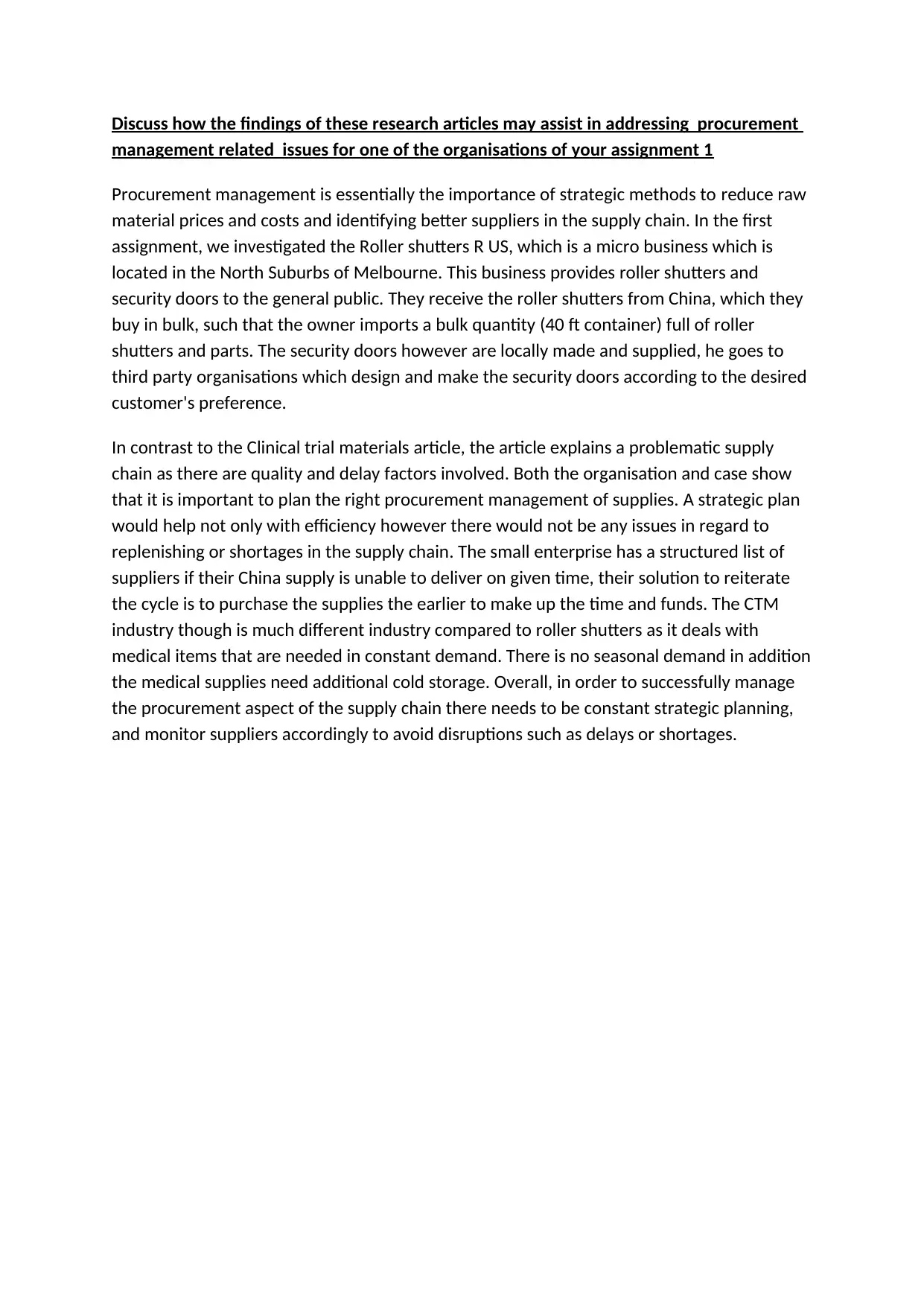
Discuss how the findings of these research articles may assist in addressing procurement
management related issues for one of the organisations of your assignment 1
Procurement management is essentially the importance of strategic methods to reduce raw
material prices and costs and identifying better suppliers in the supply chain. In the first
assignment, we investigated the Roller shutters R US, which is a micro business which is
located in the North Suburbs of Melbourne. This business provides roller shutters and
security doors to the general public. They receive the roller shutters from China, which they
buy in bulk, such that the owner imports a bulk quantity (40 ft container) full of roller
shutters and parts. The security doors however are locally made and supplied, he goes to
third party organisations which design and make the security doors according to the desired
customer's preference.
In contrast to the Clinical trial materials article, the article explains a problematic supply
chain as there are quality and delay factors involved. Both the organisation and case show
that it is important to plan the right procurement management of supplies. A strategic plan
would help not only with efficiency however there would not be any issues in regard to
replenishing or shortages in the supply chain. The small enterprise has a structured list of
suppliers if their China supply is unable to deliver on given time, their solution to reiterate
the cycle is to purchase the supplies the earlier to make up the time and funds. The CTM
industry though is much different industry compared to roller shutters as it deals with
medical items that are needed in constant demand. There is no seasonal demand in addition
the medical supplies need additional cold storage. Overall, in order to successfully manage
the procurement aspect of the supply chain there needs to be constant strategic planning,
and monitor suppliers accordingly to avoid disruptions such as delays or shortages.
management related issues for one of the organisations of your assignment 1
Procurement management is essentially the importance of strategic methods to reduce raw
material prices and costs and identifying better suppliers in the supply chain. In the first
assignment, we investigated the Roller shutters R US, which is a micro business which is
located in the North Suburbs of Melbourne. This business provides roller shutters and
security doors to the general public. They receive the roller shutters from China, which they
buy in bulk, such that the owner imports a bulk quantity (40 ft container) full of roller
shutters and parts. The security doors however are locally made and supplied, he goes to
third party organisations which design and make the security doors according to the desired
customer's preference.
In contrast to the Clinical trial materials article, the article explains a problematic supply
chain as there are quality and delay factors involved. Both the organisation and case show
that it is important to plan the right procurement management of supplies. A strategic plan
would help not only with efficiency however there would not be any issues in regard to
replenishing or shortages in the supply chain. The small enterprise has a structured list of
suppliers if their China supply is unable to deliver on given time, their solution to reiterate
the cycle is to purchase the supplies the earlier to make up the time and funds. The CTM
industry though is much different industry compared to roller shutters as it deals with
medical items that are needed in constant demand. There is no seasonal demand in addition
the medical supplies need additional cold storage. Overall, in order to successfully manage
the procurement aspect of the supply chain there needs to be constant strategic planning,
and monitor suppliers accordingly to avoid disruptions such as delays or shortages.
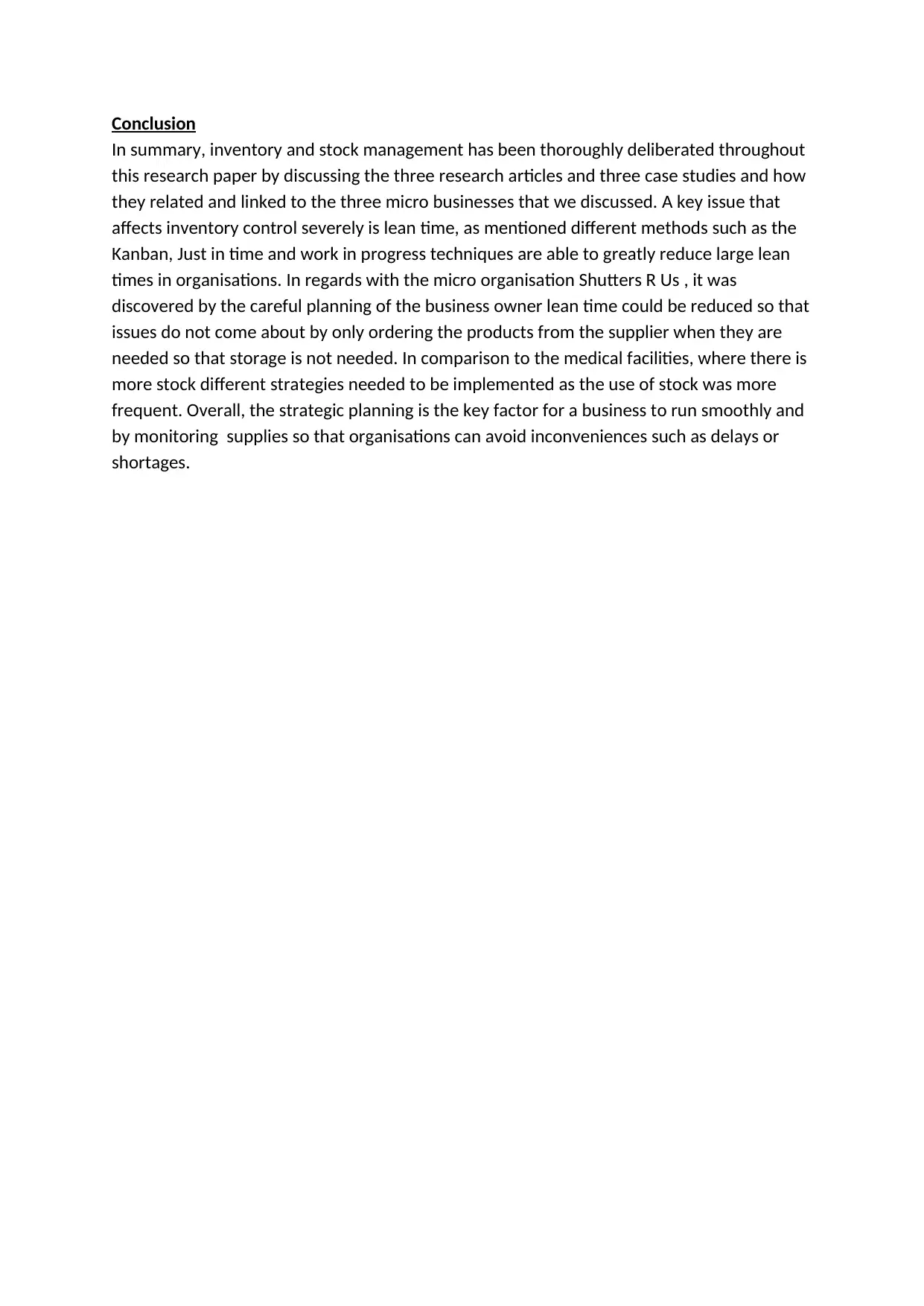
Conclusion
In summary, inventory and stock management has been thoroughly deliberated throughout
this research paper by discussing the three research articles and three case studies and how
they related and linked to the three micro businesses that we discussed. A key issue that
affects inventory control severely is lean time, as mentioned different methods such as the
Kanban, Just in time and work in progress techniques are able to greatly reduce large lean
times in organisations. In regards with the micro organisation Shutters R Us , it was
discovered by the careful planning of the business owner lean time could be reduced so that
issues do not come about by only ordering the products from the supplier when they are
needed so that storage is not needed. In comparison to the medical facilities, where there is
more stock different strategies needed to be implemented as the use of stock was more
frequent. Overall, the strategic planning is the key factor for a business to run smoothly and
by monitoring supplies so that organisations can avoid inconveniences such as delays or
shortages.
In summary, inventory and stock management has been thoroughly deliberated throughout
this research paper by discussing the three research articles and three case studies and how
they related and linked to the three micro businesses that we discussed. A key issue that
affects inventory control severely is lean time, as mentioned different methods such as the
Kanban, Just in time and work in progress techniques are able to greatly reduce large lean
times in organisations. In regards with the micro organisation Shutters R Us , it was
discovered by the careful planning of the business owner lean time could be reduced so that
issues do not come about by only ordering the products from the supplier when they are
needed so that storage is not needed. In comparison to the medical facilities, where there is
more stock different strategies needed to be implemented as the use of stock was more
frequent. Overall, the strategic planning is the key factor for a business to run smoothly and
by monitoring supplies so that organisations can avoid inconveniences such as delays or
shortages.
⊘ This is a preview!⊘
Do you want full access?
Subscribe today to unlock all pages.

Trusted by 1+ million students worldwide
1 out of 13
Related Documents
Your All-in-One AI-Powered Toolkit for Academic Success.
+13062052269
info@desklib.com
Available 24*7 on WhatsApp / Email
![[object Object]](/_next/static/media/star-bottom.7253800d.svg)
Unlock your academic potential
Copyright © 2020–2025 A2Z Services. All Rights Reserved. Developed and managed by ZUCOL.





